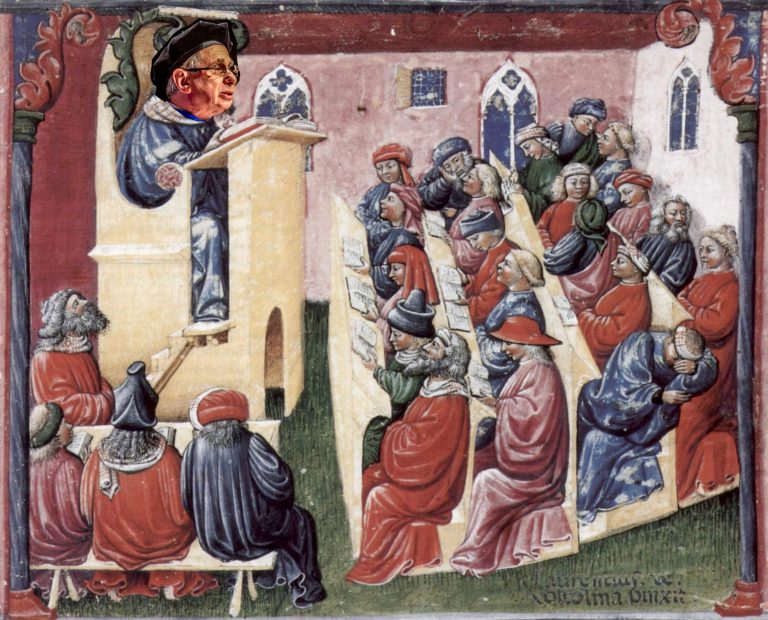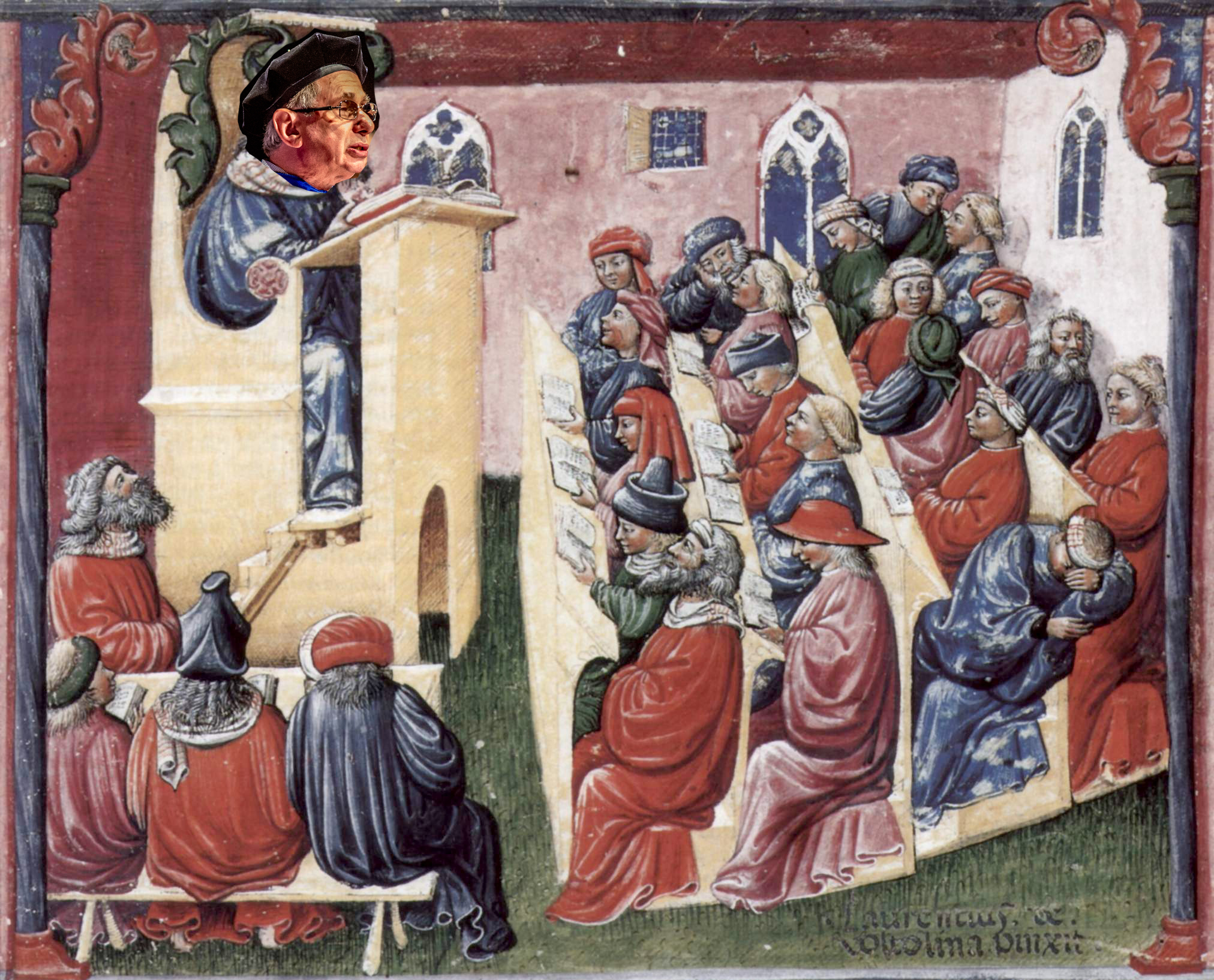Center for the Future of the Health Professions June 2021 column: Confessions of a recovering sage-on-the-stage performer
Posted: June 1, 2021
This month, The Center for the Future of the Health Professions will be posting another monthly op-ed column for 2021. Our columns represent strong, informed, and focused opinions on issues that affect the future of the health professions. As mentioned in the past, the center was developed to provide state, local, and national policymakers and health system stakeholders with accurate, reliable, and comprehensive data and research about the healthcare workforce, so they can effectively plan for a sustainable future and make the best use of available resources.
This month features a discussion surrounding the traditional classroom lectures for health professions students and the role of faculty, titled “Confessions of a recovering sage-on-the-stage performer” by Norman Gevitz, PhD, professor of history and sociology of health professions and senior vice president-academic affairs at A.T. Still University (ATSU).
If classrooms were judged on the basis of a Broadway show, and only 20% of the seats were filled for each and every presentation, the actors would be fired and the show would close. And yet, unless classroom attendance is mandatory, the lecture halls of health science universities are largely empty. Many students believe there is nothing to be gained by getting up from bed, their couch, or a desk chair to attend a 50-minute or longer live performance. If the lecture is recorded they can play it at warp speed, getting the gist of what’s being said, with little concern about what they might be otherwise missing.
The thing about lecture performances is that they are usually an extended soliloquy of something that is replicated more fully in a textbook. And unless the relevant textbook pages are written in a confusing way, the textbook alone can suffice for understanding the material. And especially now when the Internet offers a host of resources to answer any basic science or clinically-related question, the lecture—the hallmark of medieval learning—would seem to be irrelevant—but it’s not—and not to the credit of this form of content delivery.
Then what is the purpose of the lecture to faculty members and students? For faculty members, lecturing is the traditional means by which they can convey their erudition, the fruit of their years in graduate school and beyond. For those of us (myself included), it is also an opportunity to be on a stage, to have the eyes of the audience fixed upon you where one not only can educate—but frankly entertain. Faculty know students constitute a fickle audience whose criteria for giving their professors positive reviews may not accurately reflect students’ mastery of the material. And too often, faculty will adjust their sights and tailor their presentations to expressed student needs which is not necessarily learning, per se.
In more than three decades in the classroom, some of the questions I’m most often asked (whether during a lecture, right after the class is over, or during office hours) are “what subjects will the test cover?” or “is this a question on the exam?” From the standpoint of a student, these are natural questions to ask. What these questions reflect is the large amount of content in your particular class or all classes they are currently taking, which often dwarfs what they were responsible for as undergraduates. To many students the volume of material and the expectations seem overwhelming. For these anxiety-ridden students, they yearn for the means to lessen the burdens of study, and are most happy to reward those faculty with glowing reviews who provide guidance or short cuts for them to do well on exams.
In a course syllabus, the student is usually provided a number of pages in a textbook to read, digest, and master during the period before the exam. The student has to create a prioritization list whereby she/he has to determine what topics “seem” more vital than others and to apportion to the various topics what limited time they have on the basis of their apparent importance. The lecture, and most particularly, the incorporated PowerPoint presentation, is one potential aid to students, for it is widely perceived as the instructor’s own perception of the relative importance of the subjects covered in the text. And indeed, students reward those professors with good reviews who are known to restrict their test questions to the PowerPoint or what they otherwise cover in the lecture while eschewing questions found solely in the textbook, making the latter source all but irrelevant. In my earlier teaching and assessment experience, I tried basing approximately one out of every four or five multiple-choice questions on the textbook rather than on the PowerPoint or lecture, as these textbook-based questions reflected stated learning objectives provided to the students. Not surprisingly, I found students as a whole did not generally do as well on these textbook-based questions and some of those students did not hide their dissatisfaction with my question choices in their end-of-course reviews of my teaching.
Over time, I grew increasingly dissatisfied with the lecture as my primary teaching tool. In looking at my exam results, particularly my essay question responses, I found a high percentage of students did not satisfactorily understand the material. Too many just barely passed. Are they really learning, or just regurgitating what I was presenting in the PowerPoint or in my lecture? Overall, I received good reviews for my “theatrics”—words like “engaging,” “humorous,” “doesn’t put you to sleep,”—but where early in my career I loved these reviews, now they were bothering me. Maybe I was good as an entertainer, maybe students were showing up, but were they actually leaning as much as I hoped. Part of the problem of being an entertainer-teacher is that while you may be getting them to show up or keeping them awake, students are not focusing on or thinking deeply about the content of the subject matter. Most importantly, my presentations were still a form of “passive” learning. They were sitting in their seats, focused on being “entertained,” expecting me to tell them all they needed to know. Laughter at my asides may have been one form of audience interaction but it is definitely not interactive learning nor is it active student learning.
My self-questioning occurred in the years following my arrival at the Ohio University College of Osteopathic Medicine. There, the dean, not satisfied with the outcomes of a systems-based curriculum, charged the curricular dean and the faculty with coming up with a new curricular model. In fact, they devised two new curricula—one centered on a problems-based model pioneered by the Southern Illinois University College of Medicine and the second, a clinical presentation model pioneered by the University Of Calgary Faculty of Medicine. The “problem-based model” eliminated all lectures (unless requested by students on given topics) and the Calgary model reduced the number of lectures somewhat. Both models were focused on small-group learning sessions on given clinical presentations. In the problem-based model, the students devised their own learning objectives, in the Calgary model, the faculty provided the learning objectives. In addition to doing my usual lecturing in the Calgary-based curriculum, I was a faculty facilitator in both curricula.
At first, I wondered what my role was as a faculty member in facilitation. We were taught not to be content experts but rather facilitate group discussion making sure that all of the students were prepared and contributed to the analysis of the case. We were to intrude in the discussion only when it veered off course. Initially, I was demoralized because of my diminished role. But then it finally dawned on me. The students were all engaged, and were actively learning which was what I wanted to achieve as a professor. And it appeared to me that our students were obtaining better assessment outcomes. While I moved things along on occasion, I began to feel privileged at simply being a witness to students’ own progressive mastery of material.
Nonetheless, I decided to innovate. In both the problem-based and clinical presentation facilitations, when the students were finished with a case having completed all the learning objectives, having analyzed all the test results and imaging, and satisfied with the diagnosis they made, I added another element. I challenged the students, with me playing a patient with the agreed-upon diagnosis, and asked a student volunteer to explain to me, what I suffered from and how she/he was going to manage my condition. The first time I did this, the student, a little flustered, responded to my question “what’s the matter with me, doc?” by immediately saying “well, the good news is you are not going to die from this.” Our group erupted in laughter. Obviously, it was one thing to be analytical in the investigation and quite another skill, in relating clear information in an appropriate way to patients.
My second innovation was to transform the lectures I gave, which I started doing at Ohio but more regularly when I joined the faculty at the New York College of Osteopathic Medicine which had a problem-based curriculum and a systems-based curriculum, the latter curricula consisting of lectures only. In my 50-minute sessions, I “lectured” for five or ten minutes tops and then provided the students with a multi-layered problem, broken up into discrete parts. I allowed the students to discuss the problem in ad-hoc small groups, and after several minutes randomly pointed at a group to give me an answer. Since the question I devised had many possible answers, I went around the lecture hall, microphone in hand to get the answers from several groups, often questioning them why they selected that particular answer. Then I would ask the collective whole another question, and students would again break into their ad-hoc groups, and the process again would play out. Not only were students engaged by this but I found with each succeeding presentation more students came to class. I wasn’t getting 20% of the class, I was getting 75% of the class as the word spread. More tellingly, the assessment outcomes, as measured by the quality of their responses on scenario-based clinically-oriented multiple choice questions, improved significantly!
When each of these interactive class sessions were over, I witnessed the puzzled expressions of faculty members who were scheduled to present after I was finished who never saw so many students in the lecture hall and their visible disappointment that so many of these students were now on their way out the doors. Certainly, not all students liked what I was doing. In an end-of-block set of teaching evaluations, one student acidly remarked “I certainly believe Dr. Gevitz is the laziest professor in the medical school. All he does is give us problems which we are left to figure out. I’m sorry, but I’m paying hefty tuition dollars so professors can teach me exactly what I need to know.” Clearly, some students presented with opportunities for active engagement just want to be passive learners—but my experience is that if given the opportunity to participate (with others) in their own learning, most students will choose to do so. As faculty, I believe we need to ensure that our students have more of these types of active learning experiences.
Have you initiated innovative learning activities you wish to share? Please consider submitting an essay to us for publication.
